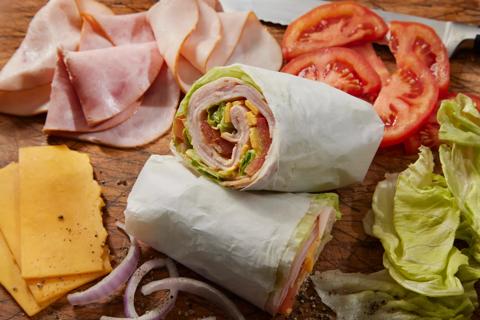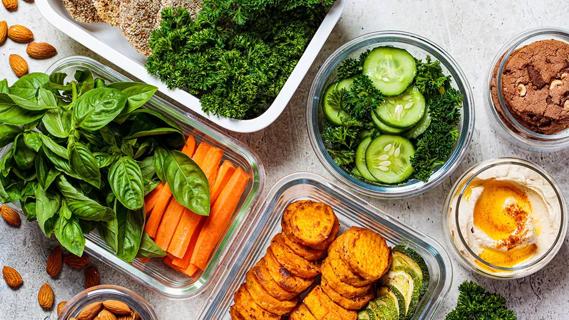Here’s what to add to your grocery list and how you can pull together cheap but healthy dinners

Your budget is stretched thin, but you don’t want to eat packaged ramen or boxed macaroni and cheese every night. While those meals are low-cost, they’re not nutritious — hello, sky-high sodium and processed ingredients.
Advertisement
Cleveland Clinic is a non-profit academic medical center. Advertising on our site helps support our mission. We do not endorse non-Cleveland Clinic products or services. Policy
The good news: You can eat nutrient-rich foods even when you’re strapped for cash. You just need a few strategies for filling your cart with cheap, healthy foods.
“It’s a myth that only people with a big bank account can afford to eat healthy,” says registered dietitian Anthony DiMarino, RD. He shares tips for creating a grocery list of healthy foods on a budget.
Whole and minimally processed foods will give you the most nutritional bang for your buck. But grocery shopping on a budget takes planning to get the best prices. Here’s how you can save money on groceries:
The food you keep in your fridge — dairy products, meat and fresh fruits and vegetables — spoils faster than canned or frozen foods. If you don’t buy the exact right quantities, it’s like throwing money in the trash.
Instead, stock up on canned and frozen fruits, vegetables and meats. They last longer, and they’re usually cheaper, too. And frozen fruits and vegetables are preserved at the peak of ripeness.
Just make sure to avoid these pitfalls:
Advertisement
Coupons give you a discount on food. Clip paper ones or download your grocery store’s app to access their digital coupons. Many larger markets even offer a special, one-time coupon that gives you a chunk off your total bill when you sign up on their app.
Coupons are a great way to save money on groceries. Just don’t start buying items you don’t need simply because you have a coupon for them. Stick to what you were already planning to purchase.
A weekly meal plan is helpful. It keeps you from buying last-minute convenience foods or items you don’t need. It also allows you to plan your meals around what’s on sale. Check out your grocery store’s weekly deals — markets post them in their digital apps and often mail flyers — to see what’s on special and in season.
Some grocery stores have a day when their weekly deals overlap. So, one set of deals is ending while the other is starting. It’s typically in the middle of the week. If you hit the store on that day, you’ll have access to the most discounts.
Many stores offer their own labeled products for everything from tea to canned tomatoes to cooking oil. Look for these right next to the name-brand items. They’re usually cheaper than name-brand products — unless the name-brand products are on sale or you have a coupon for them.
Cut out the middle step and go directly to the farmer for fresh produce, DiMarino says. Farmers markets are a great place to pick up affordable produce.
“Go at the end of the day and bargain with the farm stands,” he suggests. “They’re sometimes willing to sell their remaining inventory for less so that they don’t have to pack it up or let it go to waste.” But steer clear of artisanal and expensive foods like sauces, mushrooms and dips.
You might be surprised at what you can find at dollar stores. Many have a grocery aisle or two, plus a few small refrigerated units. Amid the numerous unhealthy choices like chips, cookies and candy, you can also find a few healthy foods. Products to pick up include:
When the cupboards are bare, you’re more likely to eat fast food or grab a box of mac and cheese. But some of the healthiest foods are cheap. So, stop yourself from noshing on non-nutritious grub by stocking your kitchen with these healthy staples:
Advertisement
“Try to hit all the major food groups when planning meals, even when you’re on a budget,” says DiMarino. Here are some inexpensive, healthy meal ideas:
Use whole-grain pasta, which has more fiber and nutrients than regular pasta.
Combine it with homemade marinara or jarred sauce that’s low in sodium and sugar. Sprinkle it with some Parmesan cheese and pair it with a fresh salad tossed with oil and vinegar.
Bake or grill chicken breasts (those frozen ones come in handy!) and serve with brown rice and a side of veggies.
You can also get creative by adding spices to suit your taste, as they don’t contain calories or fat. Try this Jamaican jerk chicken breast recipe, to start. Just watch sodium levels, if you’re using a mixed seasoning.
This Asian-inspired dish is simple to make. Just cook sliced chicken breasts and whatever vegetables you like in a little bit of oil. Broccoli, carrots and onions work well and are relatively inexpensive. You can add low-sodium soy sauce for a salty flavor but avoid teriyaki sauces, which are typically high in sugar.
Make a big batch of chili, but skip the meat. It’s just as flavorful, and beans have around 40 grams of protein per cup — about the same as a chicken breast. Use leftovers to top baked potatoes another night.
Advertisement
Making healthy food choices significantly impacts how you feel — now and in the years to come. A heart-healthy diet keeps your ticker going strong and can prevent diseases like Type 2 diabetes.
“Eating affordably and healthy doesn’t have to be a challenge,” DiMarino says. With these tips, your diet can help you feel good — and fit your budget.
Advertisement
Learn more about our editorial process.
Advertisement

With a focus on internal cues for hunger and fullness, this eating style may revolutionize your relationship with food

Review the ingredients, watch for sugar and fat, and choose one with the right amount of protein for your needs

A typical recommended balanced diet is half fruits and veggies, a quarter protein and a quarter grains

Foods high in protein, fiber and water can help keep hunger at bay

This quirky food trend is harmless, as long as you’re getting enough protein, fiber and healthy fats

This vital nutrient helps your brain and body in many ways — and most of us need more of it

Wrapped or sandwiched, try to choose fillings and condiments that are minimally processed, low in saturated fat and high in fiber

Set yourself up for success by carefully choosing your recipes, storage containers and prepping day

The best parenting style balances enforcing rules and showing plenty of love

Tips include cutting back on sugar, focusing on exercise and managing stress

It can be harder to let go when you’ve invested time, energy and emotions — but it might be the healthier choice long term